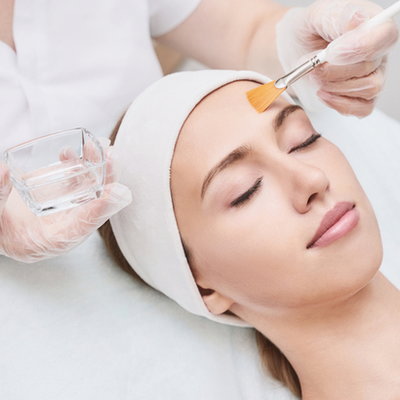 OVERVIEW
OVERVIEW
Also known as chemoexfoliation, chemical peels are popular cosmetic procedures that exfoliate and rejuvenate your skin.
Depending on your aesthetic needs, chemical peels come in three main types: light, medium, or deep, with deeper chemical peels making use of stronger chemical agents to treat deeper wrinkles and scarring.
Chemical peels work by stimulating your body’s own healing mechanism, including the production of collagen and elastin which leads to the thickening of your skin’s outermost layer—the epidermis—and an overall increase in volume and suppleness.
What are the Different Types of Chemical Peels Available?
A popular treatment for skin resurfacing at the dermatologist, chemical peels can be of three main types:
– Light Chemical Peels
Superficial or light chemical peels make use of low-potency acids such as retinoic acid and salicylic acid. They require minimal downtime—with your skin healing after a week—and are used to treat redness and milder pigmentation issues.
– Medium Chemical Peels
Medium peels penetrate deeper into your skin’s layers, reaching the middle layer of your skin. They’re typically used to treat fine lines and wrinkles, as well as symptoms of sun damage like freckles and age spots. Since medium chemoexfoliation has a deeper reach, the downtime after your procedure is longer, with signs of swelling, redness, and peeling for several days post-treatment.
– Deep Chemical Peels
Deep chemical peels target skin cells deep within your skin’s layers. A board-certified dermatologist will recommend a deep peel if you have deep-set wrinkles and scars. Deep peels require a more extended recovery period, during which your face is bandaged and requires at least three weeks to heal.
What are Chemical Peels Used For?
Chemoexfoliation is used for a variety of different cosmetic reasons, including for reducing redness and hyperpigmentation. Pigment disorders, inflammatory disorders like rosacea, scarring due to surgery and trauma, as well as signs of aging are all common reasons why you may seek out a chemical peel treatment.
Chemical peels can also be used to treat:
- Wrinkles
- Acne scarring
- Damage caused due to exposure to the sun
- Textured skin
Treatment with Chemical Peels is Safe When Performed by a Board-Certified Dermatologist
If you’re looking to rejuvenate your skin, and treat acne scars and hyperpigmentation, then a chemical peel may be right for you.
While most peels are done in a dermatologist’s office, deep peels require general anesthesia and are typically carried out in an outpatient facility. If you’re not ready for a deep peel, your board-certified dermatologist can offer a superficial peel that makes use of similar ingredients in popular over-the-counter anti-aging products.
Scheduling an appointment with a board-certified dermatologist will help determine the chemical peel that’s right for you based on your symptoms, overall health, and desired outcomes.


